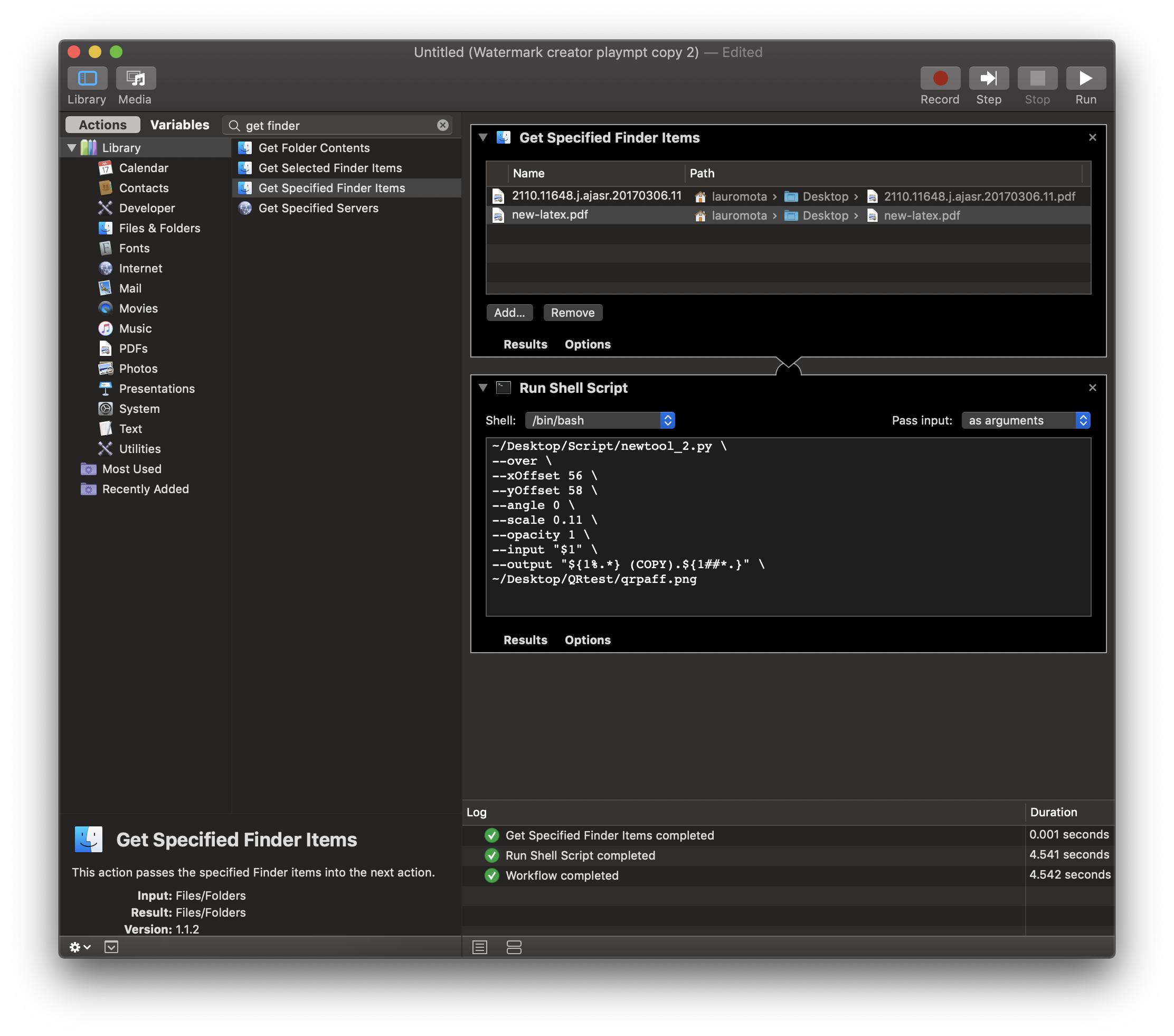I am trying to create a script to watermark a group a PDF files in a folder, each PDF has to have a unique watermark.
All the PDFs are in one folder, all the watermarks are in .png located in another folder. I currently have watermark script which I found on Apple Forums, but this was made to watermark all files with one watermark only.
What I need is a way to watermark each PDF file with it's own different watermark (there are 400 pdfs and 400 different watermarks)
Here is the contents of the watermark tool.py:
#!/usr/bin/python # Watermark each page in a PDF document import sys #, os import getopt import math from Quartz.CoreGraphics import * from Quartz.ImageIO import * def drawWatermark(ctx, image, xOffset, yOffset, angle, scale, opacity): if image: imageWidth = CGImageGetWidth(image) imageHeight = CGImageGetHeight(image) imageBox = CGRectMake(0, 0, imageWidth, imageHeight) CGContextSaveGState(ctx) CGContextSetAlpha(ctx, opacity) CGContextTranslateCTM(ctx, xOffset, yOffset) CGContextScaleCTM(ctx, scale, scale) CGContextTranslateCTM(ctx, imageWidth / 2, imageHeight / 2) CGContextRotateCTM(ctx, angle * math.pi / 180) CGContextTranslateCTM(ctx, -imageWidth / 2, -imageHeight / 2) CGContextDrawImage(ctx, imageBox, image) CGContextRestoreGState(ctx) def createImage(imagePath): image = None # provider = CGDataProviderCreateWithFilename(imagePath) # FIXED: replaced by the following CGDataProviderCreateWithURL() url = CFURLCreateFromFileSystemRepresentation(kCFAllocatorDefault, imagePath, len(imagePath), False) provider = CGDataProviderCreateWithURL(url) if provider: imageSrc = CGImageSourceCreateWithDataProvider(provider, None) if imageSrc: image = CGImageSourceCreateImageAtIndex(imageSrc, 0, None) if not image: print "Cannot import the image from file %s" % imagePath return image def watermark(inputFile, watermarkFiles, outputFile, under, xOffset, yOffset, angle, scale, opacity, verbose): images = map(createImage, watermarkFiles) ctx = CGPDFContextCreateWithURL(CFURLCreateFromFileSystemRepresentation(kCFAllocatorDefault, outputFile, len(outputFile), False), None, None) if ctx: pdf = CGPDFDocumentCreateWithURL(CFURLCreateFromFileSystemRepresentation(kCFAllocatorDefault, inputFile, len(inputFile), False)) if pdf: for i in range(1, CGPDFDocumentGetNumberOfPages(pdf) + 1): image = images[i % len(images) - 1] page = CGPDFDocumentGetPage(pdf, i) if page: mediaBox = CGPDFPageGetBoxRect(page, kCGPDFMediaBox) if CGRectIsEmpty(mediaBox): mediaBox = None CGContextBeginPage(ctx, mediaBox) if under: drawWatermark(ctx, image, xOffset, yOffset, angle, scale, opacity) CGContextDrawPDFPage(ctx, page) if not under: drawWatermark(ctx, image, xOffset, yOffset, angle, scale, opacity) CGContextEndPage(ctx) del pdf CGPDFContextClose(ctx) del ctx def main(argv): verbose = False readFilename = None writeFilename = None under = False xOffset = 0.0 # FIXED: changed to float value yOffset = 0.0 # FIXED: changed to float value angle = 0.0 # FIXED: changed to float value scale = 1.0 # FIXED: added opacity = 1.0 # Parse the command line options try: options, args = getopt.getopt(argv, "vutx:y:a:p:s:i:o:", ["verbose", "under", "over", "xOffset=", "yOffset=", "angle=", "opacity=", "scale=", "input=", "output=", ]) except getopt.GetoptError: usage() sys.exit(2) for option, arg in options: print option, arg if option in ("-i", "--input") : if verbose: print "Reading pages from %s." % (arg) readFilename = arg elif option in ("-o", "--output") : if verbose: print "Setting %s as the output." % (arg) writeFilename = arg elif option in ("-v", "--verbose") : print "Verbose mode enabled." verbose = True elif option in ("-u", "--under"): print "watermark under PDF" under = True elif option in ("-t", "--over"): # FIXED: changed to "-t" from "t" print "watermark over PDF" under = False elif option in ("-x", "--xOffset"): xOffset = float(arg) elif option in ("-y", "--yOffset"): yOffset = float(arg) elif option in ("-a", "--angle"): angle = -float(arg) elif option in ("-s", "--scale"): scale = float(arg) elif option in ("-p", "--opacity"): opacity = float(arg) else: print "Unknown argument: %s" % (option) if (len(args) > 0): watermark(readFilename, args, writeFilename, under, xOffset, yOffset, angle, scale, opacity, verbose); else: shutil.copyfile(readFilename, writeFilename); def usage(): print "Usage: watermark --input <file> --output <file> <watermark files>..." if __name__ == "__main__": print sys.argv main(sys.argv[1:]) 
